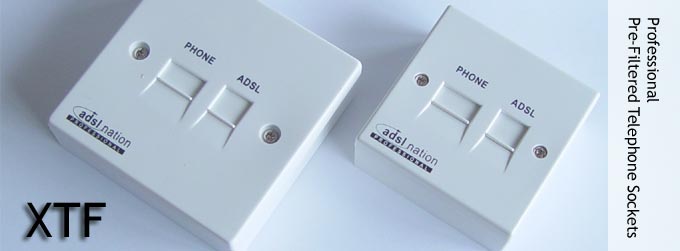I assume there the white little boxes, i was told to use 1 on each phone, never really knew why
Microfilters: Plug into the jack, then you have two jacks, one filtered for your telephone equipment and one unfiltered for the DSL modem.
The idea is that the modem must connect directly to the incoming line but that all telephones (including answering machine, fax etc.) have to go through filters. The best option is to install one filter and have all the telephone equipment connected to that single filter. The other option, not so good, is to use a microfilter at each and every location at which you use a telephone.
If you have the older-style NTE then by far the best option is to replace the existing lower connection plate with a filter designed to plug straight in in its place. For example:
http://www.adslnation.com/products/xte2005.php
On this filter you then have two sets of terminals for filtered line (to your telephones) and unfiltered line (to your modem). If the modem is being connected at the master location, then you can just use the jack provided there and run regular telephone extension wiring to your other locations.
If you want the modem elsewhere, then you want to run a dedicated pair from the A & B terminals on the filter to the modem jack. Keep the telephone wiring completely separate on different pairs. You also want to avoid the situation in which the DSL pair goes to a jack into which the modem is connected but then continues on elsewhere. This is what you have at the moment (with multiple filters) by having it plugged into the first extension jack. The extra wiring beyond the point at which the modem is connected creates a bridge tap which can cause signal degradation.
How important this is in terms of affecting performance depends on a good many factors. If you're close to the exchange with good signal levels then the small amount of degradation which can result from using multiple microfilters (which, in general, are of lower quality), having bridge taps, etc. probably won't make a significant enough difference to be worth worrying about. If, on the other hand, you're at the end of 5 miles of wire with lower signal levels, as I used to be, the difference such things can make can be quite significant.
Another problem with the use of multiple microfilters and the unfiltered line run to every jack is that if you forget about the filter sometime and plug a telephone directly into the unfiltered line, you risk causing your broadband connection to drop.
And don't use Cat-5 or higher wiring for the DSL wiring. It doesn't increase speed, and may actually cause a degradation of the signal in some cases (again, depending upon several factors as to whether it would make a significant difference in your particular circumstances).


